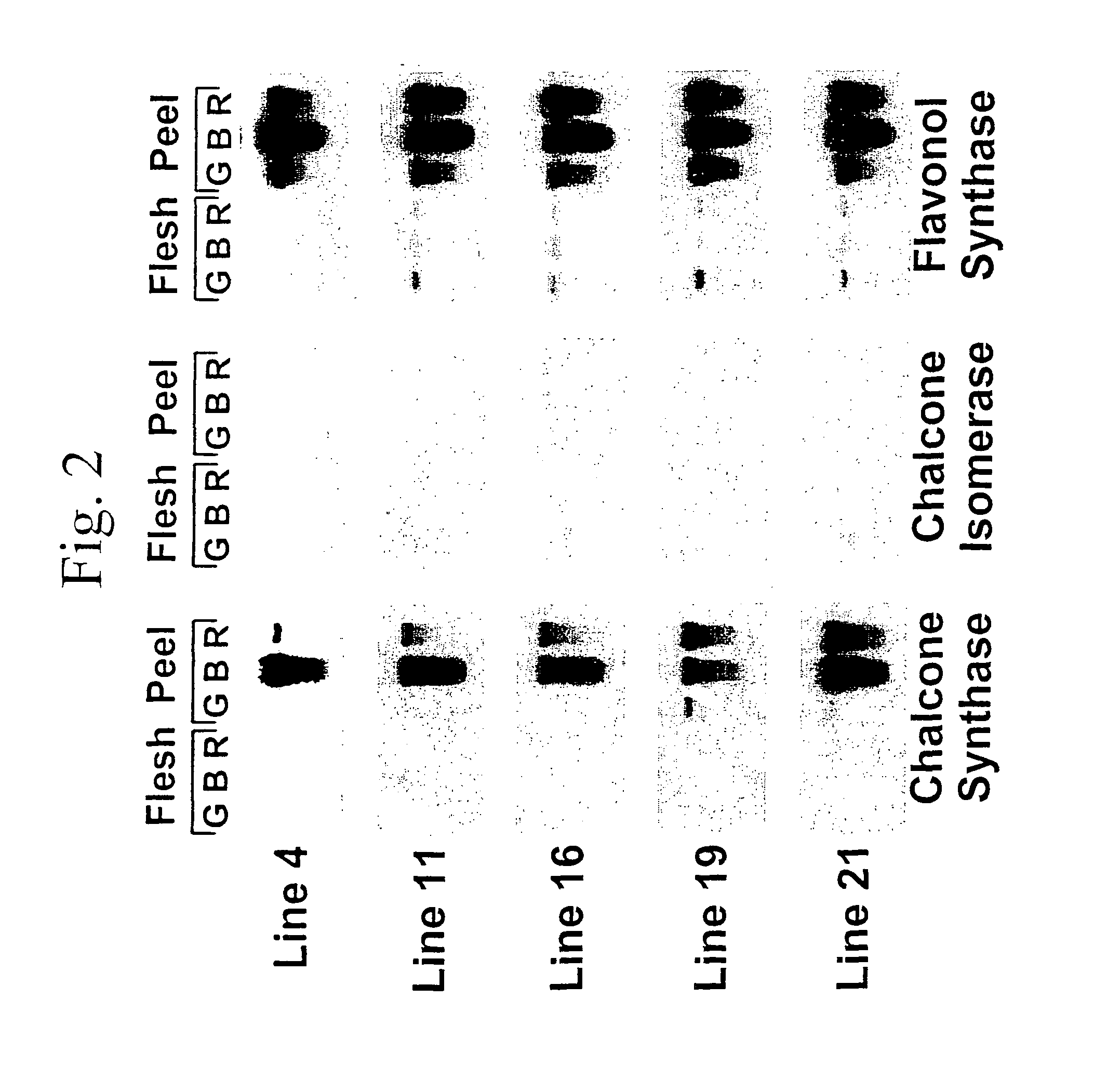Flavonol expressing domesticated tomato and method of production
a technology of domesticated tomatoes and flavonols, which is applied in the field of tomato breeding, can solve the problems that the expression of flavonol biosynthesis genes is not expressed in the flesh of the tomato fruit, the enhanced expression of flavonols is substantially limited to the tomato peel, and the inability to obtain high flavonol tomatoes by traditional breeding techniques, etc., to achieve the effect of reducing blood viscosity
- Summary
- Abstract
- Description
- Claims
- Application Information
AI Technical Summary
Benefits of technology
Problems solved by technology
Method used
Image
Examples
example i
Plant Growth and Tissue Harvest
[0050]Plants were grown in a non-soil potting mix in a greenhouse at 78 to 82° F., with 75 to 90% relative humidity, and a 16-hour photoperiod. Members of accessions LA1963, LA2884, LA1926, LA111, LA1292, and LA 1330 are self-incompatible and were pollinated by sib crossing.
[0051]Leaf tissue from each plant was harvested and frozen in liquid nitrogen. Tomato fruits were harvested at various stages of ripening: green mature, breaker, and ripe for red maturing lines; unripe and ripe for green maturing lines. Large tomatoes (L. esculentum and L. esculentum v. cerasiforme) were peeled with a knife. The peel tissue was frozen in liquid nitrogen. The seeds and locular gel were removed from the remaining tissue, and the combined pericarp and placental tissue were designated as flesh tissue and also frozen in liquid nitrogen. The peel tissue was removed from the small wild tomatoes by squeezing the tomatoes between forefinger and thumb. The internal tissues (s...
example ii
Northern Blot Analysis
[0052]Expression levels of flavonol biosynthesis genes in L. esculentum were determined by Northern analysis. Leaf tissue was finely ground in a mortar and pestle under liquid nitrogen. Fruit tissue was finely ground in a coffee grinder under liquid nitrogen. Total RNA was isolated from ground tissue according to the protocol of Lagrimini et al. (1987). For Northern blot analysis, 10 μg of RNA was loaded onto formaldehyde agarose gels and electrophoresed at 240 volts for 45 minutes. RNA was then transferred onto Hybond-N+ nylon membranes (Amersham Pharmacia Biotech).
[0053]cDNA fragments for chalcone synthase-A (CHS-A), chalcone isomerase (CHI), flavanone 3-hydroxylase (F3H), and flavonol synthase (FLS) were isolated from L. esculentum, L. pimpinellifolium (LA1261), and L. parviflorum (LA1326). The fragments were obtained from leaf RNA by RT-PCR. All fragments were sequenced and compared across species. For each cDNA, the fragments were at least 98% identical ac...
example iii
Northern Blot Analysis of L. esculentum Breeding Lines
[0057]Northern analysis was carried out on five different L. esculentum breeding lines. Total RNA was isolated from peel or flesh tissue of green, breaker, or red tomatoes and hybridized with probes for CHS-A, CHI, or FLS. As mentioned previously, little or no expression of any of the genes was detected in the fruit flesh tissue (FIG. 2). For CHS-A and FLS, expression reached a peak in peel tissue of breaker tomatoes. No fruit-localized expression was detected for CHI in any of the analyzed lines. Flavonol analysis was carried out for an additional 17 lines, but no significant differences were detected (data not shown).
PUM
| Property | Measurement | Unit |
|---|---|---|
| weight | aaaaa | aaaaa |
| pH | aaaaa | aaaaa |
| disease resistance | aaaaa | aaaaa |
Abstract
Description
Claims
Application Information
 Login to View More
Login to View More - R&D
- Intellectual Property
- Life Sciences
- Materials
- Tech Scout
- Unparalleled Data Quality
- Higher Quality Content
- 60% Fewer Hallucinations
Browse by: Latest US Patents, China's latest patents, Technical Efficacy Thesaurus, Application Domain, Technology Topic, Popular Technical Reports.
© 2025 PatSnap. All rights reserved.Legal|Privacy policy|Modern Slavery Act Transparency Statement|Sitemap|About US| Contact US: help@patsnap.com



